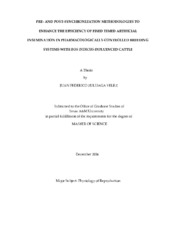| dc.contributor.advisor | Williams, Gary L. | |
| dc.creator | Zuluaga Velez, Juan Federico | |
| dc.date.accessioned | 2007-04-25T20:08:50Z | |
| dc.date.available | 2007-04-25T20:08:50Z | |
| dc.date.created | 2006-12 | |
| dc.date.issued | 2007-04-25 | |
| dc.identifier.uri | https://hdl.handle.net/1969.1/4812 | |
| dc.description.abstract | Objectives were to: 1) Evaluate the effectiveness of presynchronization with GnRH before the COâ€ÂSynch + CIDR protocol with timed AI (TAI) at 66 h in Bos indicusâ€Âinfluenced cattle; 2) Characterize ovarian events associated with the presynchronization; 3) Evaluate the efficacy of measuring vaginal electrical resistance (VER) to assess follicular maturity at TAI; and 4) Compare serum concentrations of progesterone (P4) in ovariectomized cows bearing new or previously used CIDR devices with or without autoclaving. In Exp. 1 and 2, cattle received either GnRH or saline on day â€Â7. The COâ€ÂSynch + CIDR protocol included a CIDR insert and GnRH (GnRHâ€Â1; day 0), removal of CIDR and PGF2α on day 7, and GnRH (GnRHâ€Â2) and TAI 66 h after CIDR removal. In Exp. 1, pregnancy rate of females with BCS ≥ 5 tended to differ (P=0.085) between Presynch (38%) and COâ€ÂSynch + CIDR (54%). In Exp. 2, ovulatory response to GnRHâ€Â1 was greater (P<0.01) in the Presynchronization (58%) than in the COâ€ÂSynch + CIDR (27.1%) group. Emergence of a follicular wave after GnRHâ€Â1 and ovulation rate after GnRHâ€Â2 did not differ between groups. More (P<0.01) females that developed a follicular wave after GnRHâ€Â1 ovulated (82%) after GnRHâ€Â2, compared to those that did not (29%). Mean VER (ohms) was greatest (101.4±0.8) on day 0 and declined (P<0.01) to 95.2±0.8 and 82±0.8, respectively, on days 7 and 10. We observed a low negative but significant relationship (r=0.38; P<0.001) between VER and follicular size on day 0, 7, and 10. VER difference (day 10 minus day 7) did not differ between females with small and large follicles at TAI. Mean concentrations of P4 during the 7â€Âday insertion period were greater (P<0.03) for new (3.7 ng/ml) and reâ€Âused autoclaved (3.4 ng/ml) than for reâ€Âused disinfected CIDRs (2.8 ng/ml). In summary, Presynch improved ovulation rate after GnRHâ€Â1, but did not improve pregnancy rates compared to COâ€ÂSynch + CIDR. Follicular maturity estimation was not feasible using VER as applied in this study. Autoclaving may be the best option when reâ€Âusing CIDR inserts because it creates greater concentrations of P4 during the first 48 h. | en |
| dc.format.extent | 1111228 bytes | en |
| dc.format.medium | electronic | en |
| dc.format.mimetype | application/pdf | |
| dc.language.iso | en_US | |
| dc.publisher | Texas A&M University | |
| dc.subject | Timed AI | en |
| dc.subject | Synchronization | en |
| dc.subject | Vaginal Electrical Resistance | en |
| dc.subject | Bos indicus | en |
| dc.subject | CIDR | en |
| dc.title | Pre- and post-synchronization methodologies to enhance the efficiency of fixed timed artificial insemination in pharmacologically-controlled breeding systems with Bos indicus-influenced cattle | en |
| dc.type | Book | en |
| dc.type | Thesis | en |
| thesis.degree.department | Animal Science | en |
| thesis.degree.discipline | Physiology of Reproduction | en |
| thesis.degree.grantor | Texas A&M University | en |
| thesis.degree.name | Master of Science | en |
| thesis.degree.level | Masters | en |
| dc.contributor.committeeMember | Brinsko, Steven P. | |
| dc.contributor.committeeMember | Welsh, Thomas H. | |
| dc.type.genre | Electronic Thesis | en |
| dc.type.material | text | en |
| dc.format.digitalOrigin | born digital | en |


